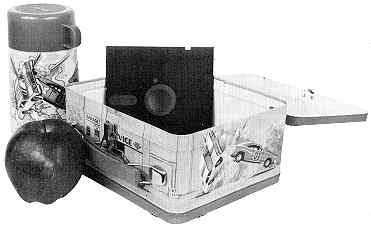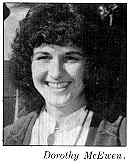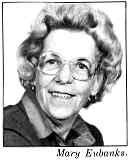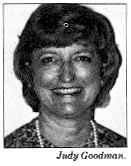
THE LABOR FORCE
A true history of the first women in personal computing
by Bonita Taylor
Bonita Taylor is editor of The Buyers
Guide series far Ziff-Davis. She is one of the few home users of the
Xerox 820 personal computer.
The tales of those
inspired pioneers who brought forth the personal computer industry have
always centered only on heroes: a few dozen obsessed males working
brilliantly against terrific odds, in the humble surroundings of
kitchens, basements and garages, nudging their ideas into a
multibillion-dollar reality. Now it's time to credit the heroines.
While no one disputes that men had the primary role
in the conception of the industry, women were the ones who went into
labor. "The women may not have always been the creative driving force,"
says Betsy Staples, editor of Creative Computing. "But they made it
possible to get the men's ideas in the public eye." The women who
worked behind the scenes (and in the basements and garages) helped many
of the newly formed computer companies grow and survive. These female
pioneers provided skills and hours beyond the call of duty and
certainly far beyond what the neonatal companies could have afforded to
pay.
The range of chores to which women were assigned
during this period was extensive. No task was unthinkable. Some of
these pioneers talk about encouraging (bribing?) their children to help
after school. Some remember spending nights in the kitchen with a Seal
a Meal machine, packaging diskettes with one hand and lunchbox
sandwiches with the other. One woman (who wishes to remain anonymous)
recalls the time an extra diskette turned up: some customer, she was
sure, would find a gooey peanut butter sandwich in his package where a
disk should have been.
Off to Market
 It's
not simply a case of good women behind good men. Unsung women have also
distinguished themselves by demonstrating their business and marketing
acumen. There's Dorothy McEwan, who in 1975 worked as a customer
support representative for the phone company while she studied computer
programming and fulfilled her responsibilities as a homemaker. The
mother of two, she was married to Gary Kildall, a Naval Postgraduate
School professor who at that time was writing the CP/M program. "He
needed things done, so I did them," Dorothy recalls. "I never thought
about what it would lead to."
It's
not simply a case of good women behind good men. Unsung women have also
distinguished themselves by demonstrating their business and marketing
acumen. There's Dorothy McEwan, who in 1975 worked as a customer
support representative for the phone company while she studied computer
programming and fulfilled her responsibilities as a homemaker. The
mother of two, she was married to Gary Kildall, a Naval Postgraduate
School professor who at that time was writing the CP/M program. "He
needed things done, so I did them," Dorothy recalls. "I never thought
about what it would lead to."
CP/M became the first commercial operating system
software distributed by a non-computer manufacturer as Dorothy, using
her business skills, helped mold and build Digital Research Inc. Today
she is a vice-president of the company, with responsibility for
marketing, communications, customer support, and educational and legal
services. But when the computer press needs a computer pioneer to
interview, the call goes out to Gary, not Dorothy.
 Mary Eubanks is another woman whose contributions have been
overlooked. After raising four children, Mary was ready to sit back,
relax and possibly start her own travel business, when suddenly she was
called upon to once again assume the role of supportive parent. Her son
Gordon had written CBASIC, the first microcomputer language to offer
reasonably good structure and commercial mathematics capability, and
had started a business to sell it. But Gordon was also a serving
officer on a strategic nuclear submarine, and it's difficult to run a
software company while sitting on the floor of the Pacific Ocean.
Mary Eubanks is another woman whose contributions have been
overlooked. After raising four children, Mary was ready to sit back,
relax and possibly start her own travel business, when suddenly she was
called upon to once again assume the role of supportive parent. Her son
Gordon had written CBASIC, the first microcomputer language to offer
reasonably good structure and commercial mathematics capability, and
had started a business to sell it. But Gordon was also a serving
officer on a strategic nuclear submarine, and it's difficult to run a
software company while sitting on the floor of the Pacific Ocean.
Mary volunteered to manage the company. "I knew
nothing about computers," she says. "But I was his mother, and I was
determined to hold the business together one way or another." She
dedicated the next few years of her life to Compiler Systems, and
Gordon came out of the Navy to an extremely prosperous company whose
CBASIC was one of the most commonly used languages.
 Then there's Judy Goodman, who in the early 1970s was working as
a substitute elementary school teacher, part-time helper in her
husband's TV and stereo shop, and full-time homemaker with three
children. During this time her husband became interested in computers,
which he saw as "the wave of the future." He educated himself and in
1977 wrote a file management program called Selector, but it was Judy
who handled the orders and the marketing (including product
distribution and trade shows) and who was responsible for staying on
top of finances. Today she is vice-president of Micro Ap, with
responsibility for marketing.
Then there's Judy Goodman, who in the early 1970s was working as
a substitute elementary school teacher, part-time helper in her
husband's TV and stereo shop, and full-time homemaker with three
children. During this time her husband became interested in computers,
which he saw as "the wave of the future." He educated himself and in
1977 wrote a file management program called Selector, but it was Judy
who handled the orders and the marketing (including product
distribution and trade shows) and who was responsible for staying on
top of finances. Today she is vice-president of Micro Ap, with
responsibility for marketing.
Cynthia Posehn, who formed Organic Software, Inc.,
recalls that "somebody had to answer the letters and the phone calls,
ship the software and manage the money." In 1977, when her husband
Michael needed a software customization proposal typed up, she was
assigned the task. "I'm a terrible typist," she says, "and it took
forever to get it out." Michael got impatient and decided that a word
processing program was needed. Textwriter was written shortly
thereafter. "His intelligence and drive got the company going," Cynthia
admits. "He placed the ads and made the contacts." But Cynthia did all
the packaging and saw to the printing, as well as anything else that
needed to be done. Today she is the firm's secretary-treasurer,
responsible for the financial, legal and marketing side of the business.
A Man's World
The women in these cameos arrived in the personal computer industry by
accident, but they share similar characteristics. They are tolerant,
determined, competent, hard-working and willing to take on something
new. And they are dependable. They were expected to work on behalf of
the men they knew and to tend all phases of the business. And they did.
Nonetheless, despite the significant contributions
of these and numerous other women during personal computing's formative
years, publicity and credit for the accomplishments of their respective
companies have continued to go to men. "As journalists, we wanted
interesting personalities as well as `names,' " says Maggie Canon, the
editor of A + magazine. "The more famous someone became, the more
interesting that person was to write about. The companies themselves
promoted the men."
According to the National Science Foundation, women
represent 26 percent of the computer labor force. We don't know how
many in this group have made critical contributions to their companies.
What we do know is that the success of the early entrepreneurial
companies shaped the computer industry as it is today. To survive the
early period, each needed not only the ideas contributed by their
heralded entrepreneurs (men), but also the skills of the various
unheralded women.
 Would the personal computer industry exist as we know it without
them? "Probably not," says Nancy Lehman, another pioneer. "This society
is not taught to acknowledge what women do and what would happen if we
stopped."
Would the personal computer industry exist as we know it without
them? "Probably not," says Nancy Lehman, another pioneer. "This society
is not taught to acknowledge what women do and what would happen if we
stopped."
It may be that if women are to be recognized for
their achievements, they will have to write the chapters themselves.
This is only the first.
Return to Table of Contents | Previous Article | Next Article

